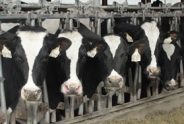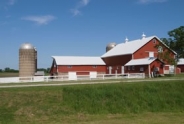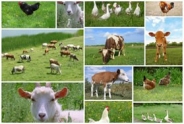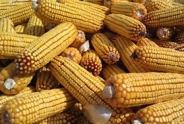Assessing Calf Dehydration by Dr. Jennifer Trout
Alycia Drwencke, Dairy Management Specialist
Southwest New York Dairy, Livestock and Field Crops Program
Determining dehydration and rehydration
Dehydration in calves experiencing scours is often underestimated. A scouring calf can lose anywhere between 5 to 10% of its body weight in water within one day. Dr. Jennifer Trout, Western U.S. Calf and Heifer Technical Pro, offers her insight on properly diagnosing and rehydrating scouring calves.
"Shortly after I finished vet school, I was talking with my father who was having a hard time getting his scouring calves back to good health. I offered some advice I had learned about dehydration in calves experiencing diarrhea and recommended that his 80-pound calves would need 10% of their body weight in fluids to correct their dehydration. He automatically thought that was too much but came around to trying it. Implementing my recommendations, he has seen faster turn arounds for his scouring calves."
1 - How to assess dehydration

Dehydration % - Percent of water loss relative to total body weight. Use this percent to calculate the amount of electrolyte solution for dehydrated calf.
Demeanor - Calf's appearance and reaction to feeding and stimulation. Calves start to lose energy, become lethargic, and show signs of depression at 8% dehydration.
Sunken Eyes - This is also known as enophthalmos and is often an early sign that calves are ill. To assess, pull down the lower eyelid and measure the gap at the inner corner of the eye from the eyelid.
Skin Elasticity - To measure, pinch a fold of skin on the side of the neck and rotate it 90 degrees. You will record the amount of time for the skinfold to disappear. If this fold disappears in 2 - 5 seconds, the calf is between 8 and 10% dehydrated and so forth.
Oral Treatment - Provide electrolytes in the morning in addition to their meal. Also, leave a bottle in between feedings and feed another bottle at night in addition to their meal.
IV Treatment - When a calf is 8 - 10% dehydrated, and has a poor or no suckling reflex, give fluids subcutaneous or with an IV. Consult with your veterinarian about treatment.
2 - Calculating how much fluid
"Don't underestimate how much fluid calves need to rehydrate. Use the dehydration % you determined from above and the calf's weight to calculate the amount of fluid they need."
- Estimate the Dehydration %
- Use the equation (Weight x Dehydration %). To get the amount of solution in pounds for oral or IV therapy. To convert this number to quarts, divide by 2 (1 quart = 2 pounds).
- Feed to rehydrate multiple times a day and continue feeding milk.
Example:
"An 80-pound calf that has fluid diarrhea, no skin tenting and its eyes are slightly sunk. A 6% dehydration is estimated on this calf. That's 4.8 pounds (80 multiplied by .06) of lost fluid that needs to be replenished. A quart of electrolytes weighs two pounds. This calf needs about 2 1/2 quarts (4.8 divided by 2) of electrolytes to correct its dehydration alone."
For more information on calf care, reach out to Alycia Drwencke, SWNY Dairy Management Specialist.
Upcoming Events
Crops, Cows & Critters - Southwest New York Dairy, Livestock & Field Crops Newsletter Sponsorship
December 19, 2025
Our two forms of publications feature research-based and timely information from our four specialists, listed to the right, along with local event notifications and Cornell University outreach. This information is provided to participants who range from dairy, livestock, and field crops producers to agricultural suppliers and consultants.
Weekly Email Update: Shared with 625+ households who have signed up with our program.
Monthly Paper Mailer: To reach our stakeholders and farmers who lack internet access, we send out a monthly mailer where your company's logo and contact information would be featured with a mailing list of 330+ households.
If you sponsor our weekly and monthly publications you reach approximately 955 households.
Visit our website to view our newsletters!
2025 Cornell Food Beverage & Animal Feed Manufacturer Survey
December 19, 2025
Industry and Educational Advocates for New York State's Food, Beverage, and Animal Feed Manufacturing industries:
As you know, NYS has a diverse food and beverage manufacturing industry, in both the types of industries that exist and the wide distribution of firms by scale. Many manufacturing firms have strong backward linkages to agricultural production sectors in the state that support both farm-level and downstream food industry firms and consumers. In collaboration with the New York State Department of Agriculture and Markets, a team from Cornell University's Charles H. Dyson School of Applied Economics and Management has recently rolled out the 2025 New York State Food, Beverage, and Animal Feed Manufacturer Survey. The industry will benefit from an updated assessment of the industry that informs private and public investments and opportunities to support firm growth and improved profitability.
Cornell Organic Field Crops & Dairy Conference
March 6, 2026
Waterloo, NY
Farmers, researchers, educators, and agricultural service providers from across the Northeast are invited to the 2026 Cornell Organic Field Crops & Dairy Conference, held Friday, March 6, 2026, from 8:00 a.m. to 4:30 p.m. at the Lux Hotel & Conference Center in Waterloo, N.Y.
Co-hosted by New York Soil Health and Cornell CALS, the annual conference brings together leaders in organic grain, dairy, and livestock systems to share practical tools, new research, and farmer-tested strategies to support resilient and profitable organic production.
Announcements
No announcements at this time.





